Assessing the Competence of Evidence-Informed Decision-Making Amongst Health Service Managers
VerifiedAdded on 2022/10/13
|8
|1723
|7
AI Summary
Contribute Materials
Your contribution can guide someone’s learning journey. Share your
documents today.
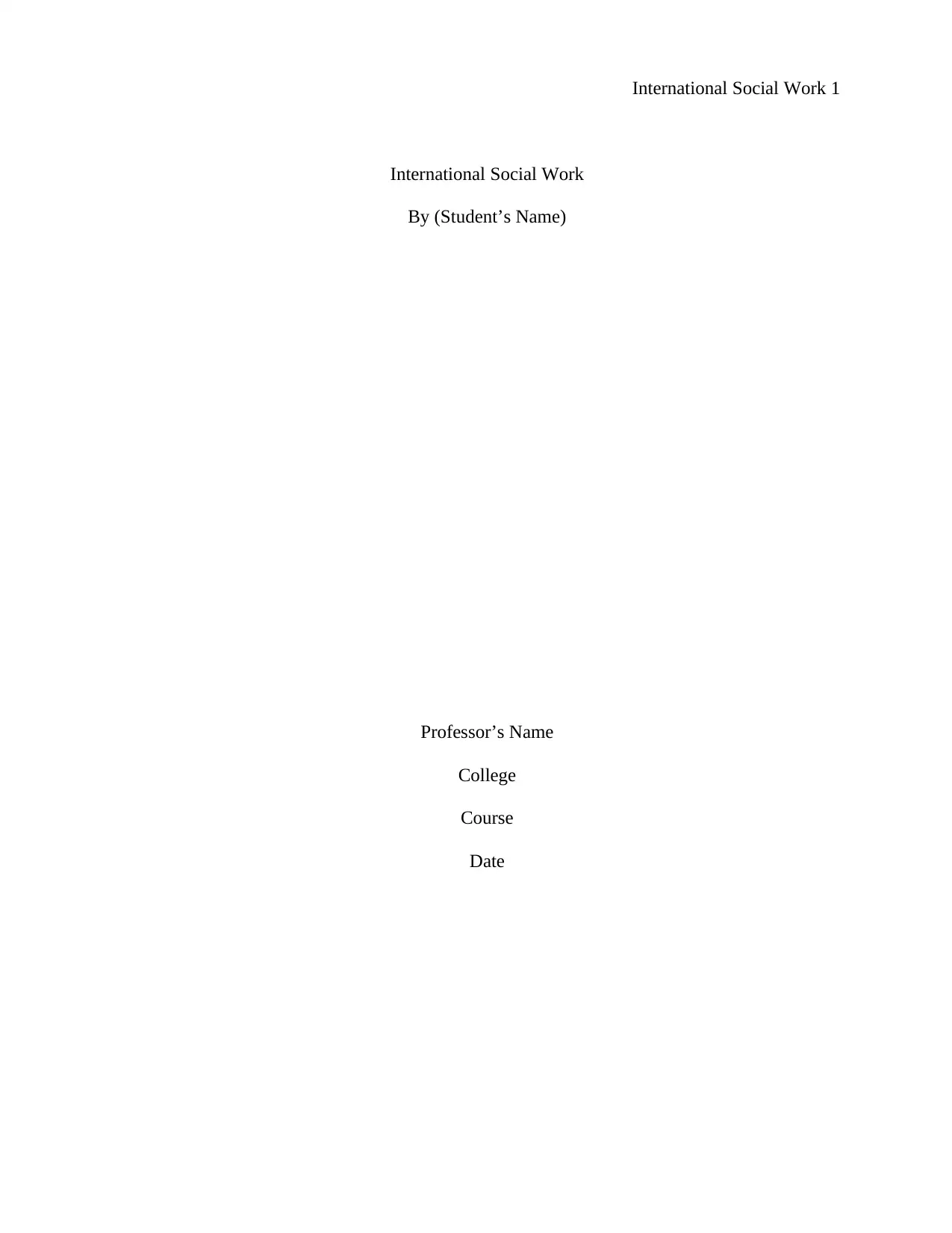
International Social Work 1
International Social Work
By (Student’s Name)
Professor’s Name
College
Course
Date
International Social Work
By (Student’s Name)
Professor’s Name
College
Course
Date
Secure Best Marks with AI Grader
Need help grading? Try our AI Grader for instant feedback on your assignments.
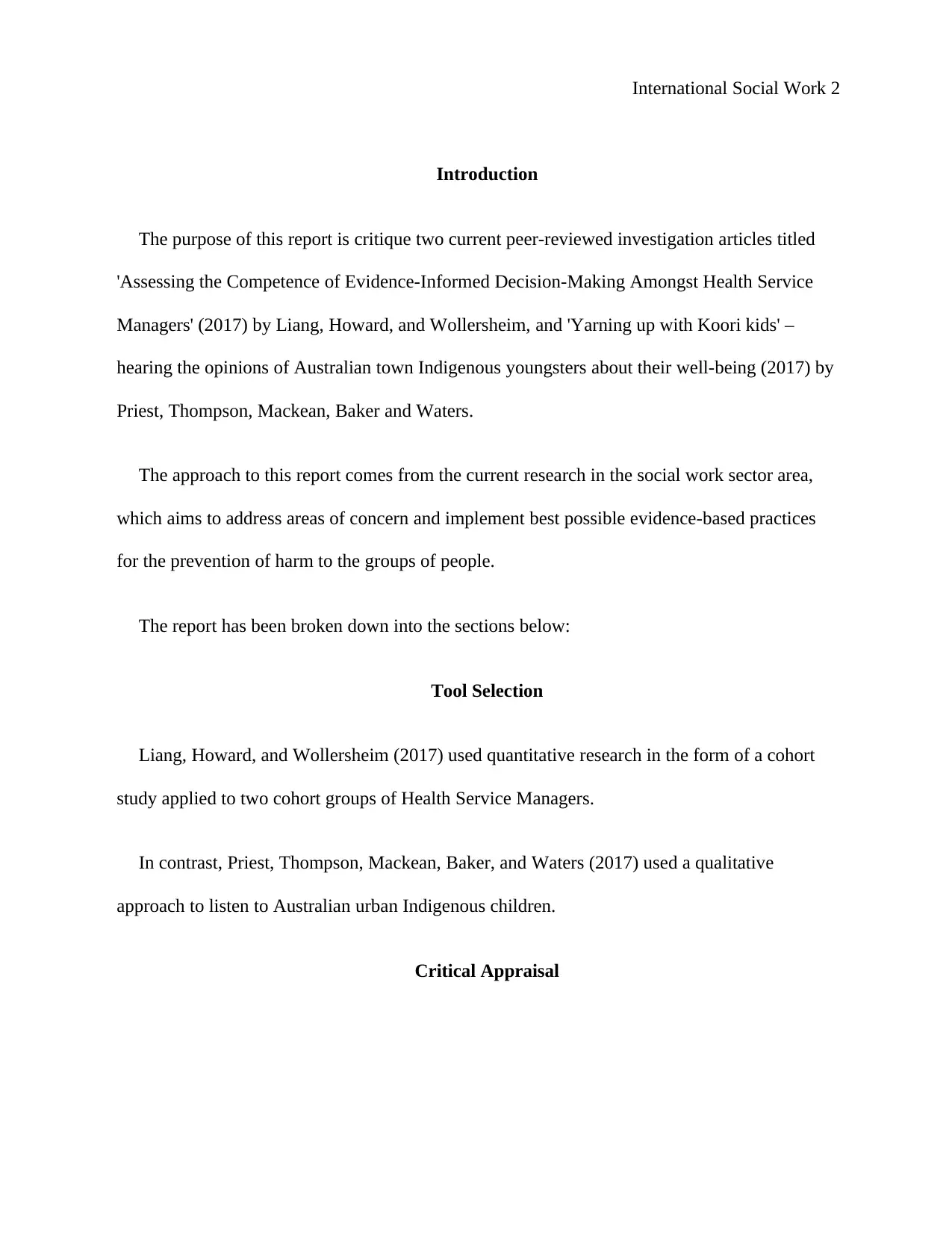
International Social Work 2
Introduction
The purpose of this report is critique two current peer-reviewed investigation articles titled
'Assessing the Competence of Evidence-Informed Decision-Making Amongst Health Service
Managers' (2017) by Liang, Howard, and Wollersheim, and 'Yarning up with Koori kids' –
hearing the opinions of Australian town Indigenous youngsters about their well-being (2017) by
Priest, Thompson, Mackean, Baker and Waters.
The approach to this report comes from the current research in the social work sector area,
which aims to address areas of concern and implement best possible evidence-based practices
for the prevention of harm to the groups of people.
The report has been broken down into the sections below:
Tool Selection
Liang, Howard, and Wollersheim (2017) used quantitative research in the form of a cohort
study applied to two cohort groups of Health Service Managers.
In contrast, Priest, Thompson, Mackean, Baker, and Waters (2017) used a qualitative
approach to listen to Australian urban Indigenous children.
Critical Appraisal
Introduction
The purpose of this report is critique two current peer-reviewed investigation articles titled
'Assessing the Competence of Evidence-Informed Decision-Making Amongst Health Service
Managers' (2017) by Liang, Howard, and Wollersheim, and 'Yarning up with Koori kids' –
hearing the opinions of Australian town Indigenous youngsters about their well-being (2017) by
Priest, Thompson, Mackean, Baker and Waters.
The approach to this report comes from the current research in the social work sector area,
which aims to address areas of concern and implement best possible evidence-based practices
for the prevention of harm to the groups of people.
The report has been broken down into the sections below:
Tool Selection
Liang, Howard, and Wollersheim (2017) used quantitative research in the form of a cohort
study applied to two cohort groups of Health Service Managers.
In contrast, Priest, Thompson, Mackean, Baker, and Waters (2017) used a qualitative
approach to listen to Australian urban Indigenous children.
Critical Appraisal
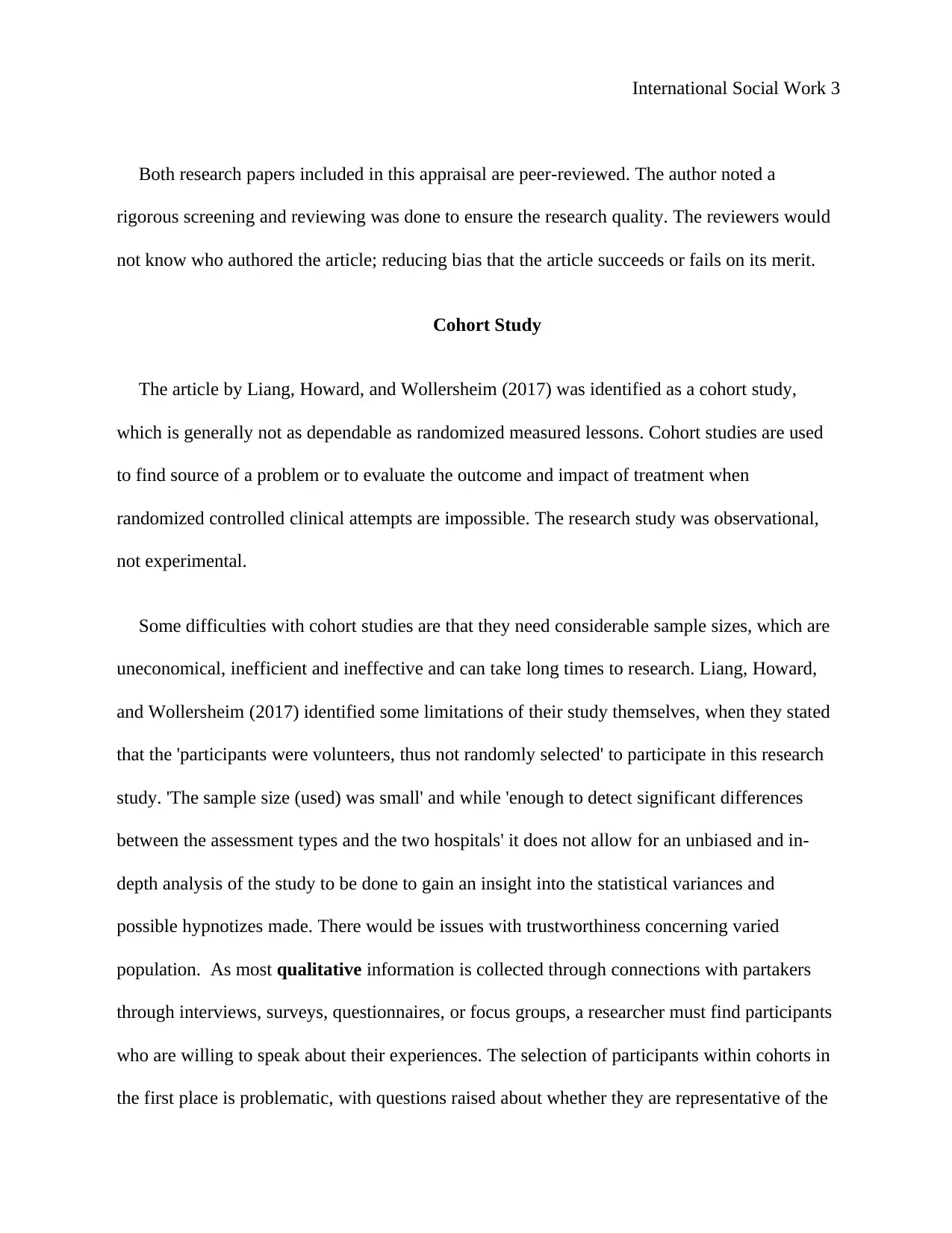
International Social Work 3
Both research papers included in this appraisal are peer-reviewed. The author noted a
rigorous screening and reviewing was done to ensure the research quality. The reviewers would
not know who authored the article; reducing bias that the article succeeds or fails on its merit.
Cohort Study
The article by Liang, Howard, and Wollersheim (2017) was identified as a cohort study,
which is generally not as dependable as randomized measured lessons. Cohort studies are used
to find source of a problem or to evaluate the outcome and impact of treatment when
randomized controlled clinical attempts are impossible. The research study was observational,
not experimental.
Some difficulties with cohort studies are that they need considerable sample sizes, which are
uneconomical, inefficient and ineffective and can take long times to research. Liang, Howard,
and Wollersheim (2017) identified some limitations of their study themselves, when they stated
that the 'participants were volunteers, thus not randomly selected' to participate in this research
study. 'The sample size (used) was small' and while 'enough to detect significant differences
between the assessment types and the two hospitals' it does not allow for an unbiased and in-
depth analysis of the study to be done to gain an insight into the statistical variances and
possible hypnotizes made. There would be issues with trustworthiness concerning varied
population. As most qualitative information is collected through connections with partakers
through interviews, surveys, questionnaires, or focus groups, a researcher must find participants
who are willing to speak about their experiences. The selection of participants within cohorts in
the first place is problematic, with questions raised about whether they are representative of the
Both research papers included in this appraisal are peer-reviewed. The author noted a
rigorous screening and reviewing was done to ensure the research quality. The reviewers would
not know who authored the article; reducing bias that the article succeeds or fails on its merit.
Cohort Study
The article by Liang, Howard, and Wollersheim (2017) was identified as a cohort study,
which is generally not as dependable as randomized measured lessons. Cohort studies are used
to find source of a problem or to evaluate the outcome and impact of treatment when
randomized controlled clinical attempts are impossible. The research study was observational,
not experimental.
Some difficulties with cohort studies are that they need considerable sample sizes, which are
uneconomical, inefficient and ineffective and can take long times to research. Liang, Howard,
and Wollersheim (2017) identified some limitations of their study themselves, when they stated
that the 'participants were volunteers, thus not randomly selected' to participate in this research
study. 'The sample size (used) was small' and while 'enough to detect significant differences
between the assessment types and the two hospitals' it does not allow for an unbiased and in-
depth analysis of the study to be done to gain an insight into the statistical variances and
possible hypnotizes made. There would be issues with trustworthiness concerning varied
population. As most qualitative information is collected through connections with partakers
through interviews, surveys, questionnaires, or focus groups, a researcher must find participants
who are willing to speak about their experiences. The selection of participants within cohorts in
the first place is problematic, with questions raised about whether they are representative of the
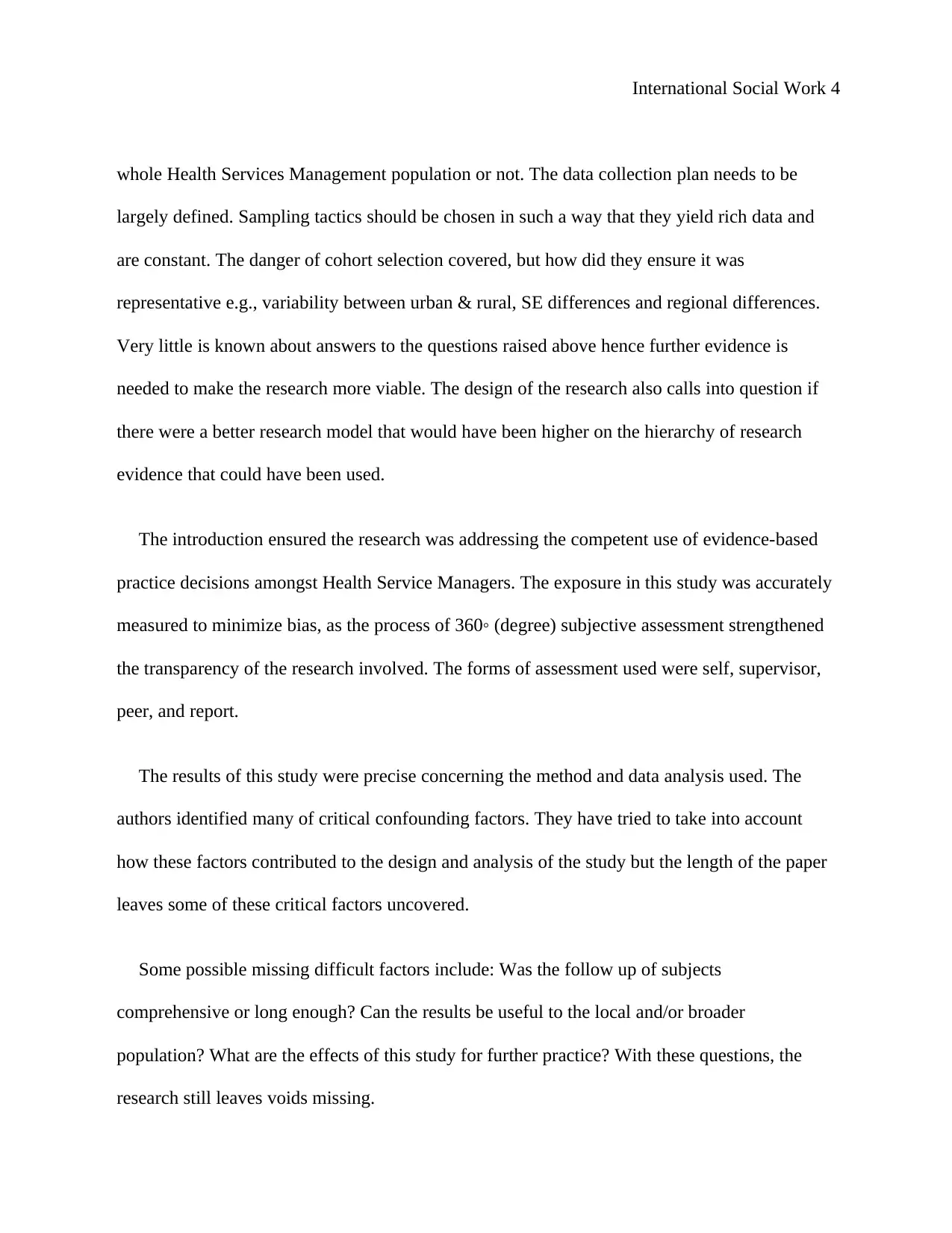
International Social Work 4
whole Health Services Management population or not. The data collection plan needs to be
largely defined. Sampling tactics should be chosen in such a way that they yield rich data and
are constant. The danger of cohort selection covered, but how did they ensure it was
representative e.g., variability between urban & rural, SE differences and regional differences.
Very little is known about answers to the questions raised above hence further evidence is
needed to make the research more viable. The design of the research also calls into question if
there were a better research model that would have been higher on the hierarchy of research
evidence that could have been used.
The introduction ensured the research was addressing the competent use of evidence-based
practice decisions amongst Health Service Managers. The exposure in this study was accurately
measured to minimize bias, as the process of 360◦ (degree) subjective assessment strengthened
the transparency of the research involved. The forms of assessment used were self, supervisor,
peer, and report.
The results of this study were precise concerning the method and data analysis used. The
authors identified many of critical confounding factors. They have tried to take into account
how these factors contributed to the design and analysis of the study but the length of the paper
leaves some of these critical factors uncovered.
Some possible missing difficult factors include: Was the follow up of subjects
comprehensive or long enough? Can the results be useful to the local and/or broader
population? What are the effects of this study for further practice? With these questions, the
research still leaves voids missing.
whole Health Services Management population or not. The data collection plan needs to be
largely defined. Sampling tactics should be chosen in such a way that they yield rich data and
are constant. The danger of cohort selection covered, but how did they ensure it was
representative e.g., variability between urban & rural, SE differences and regional differences.
Very little is known about answers to the questions raised above hence further evidence is
needed to make the research more viable. The design of the research also calls into question if
there were a better research model that would have been higher on the hierarchy of research
evidence that could have been used.
The introduction ensured the research was addressing the competent use of evidence-based
practice decisions amongst Health Service Managers. The exposure in this study was accurately
measured to minimize bias, as the process of 360◦ (degree) subjective assessment strengthened
the transparency of the research involved. The forms of assessment used were self, supervisor,
peer, and report.
The results of this study were precise concerning the method and data analysis used. The
authors identified many of critical confounding factors. They have tried to take into account
how these factors contributed to the design and analysis of the study but the length of the paper
leaves some of these critical factors uncovered.
Some possible missing difficult factors include: Was the follow up of subjects
comprehensive or long enough? Can the results be useful to the local and/or broader
population? What are the effects of this study for further practice? With these questions, the
research still leaves voids missing.
Secure Best Marks with AI Grader
Need help grading? Try our AI Grader for instant feedback on your assignments.
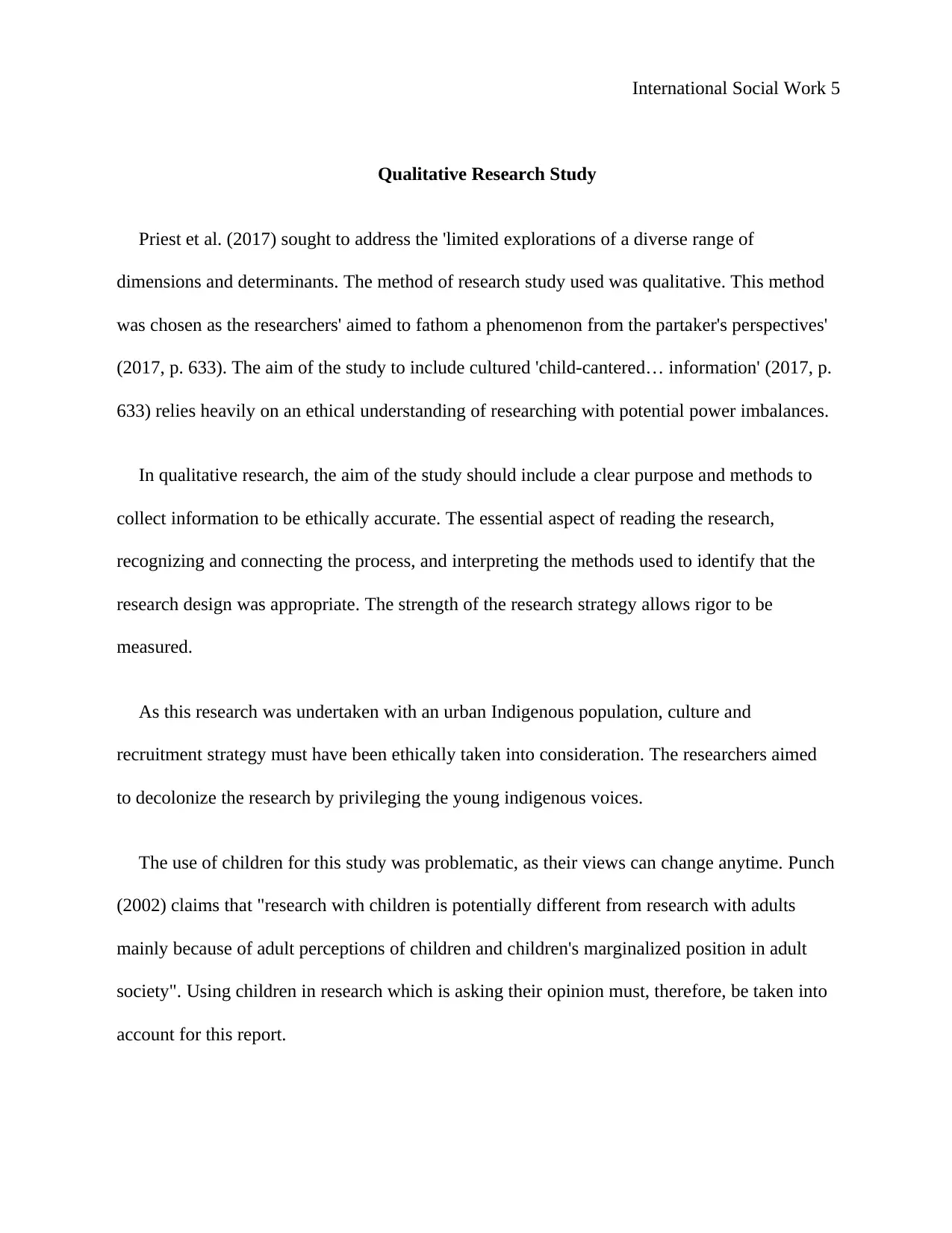
International Social Work 5
Qualitative Research Study
Priest et al. (2017) sought to address the 'limited explorations of a diverse range of
dimensions and determinants. The method of research study used was qualitative. This method
was chosen as the researchers' aimed to fathom a phenomenon from the partaker's perspectives'
(2017, p. 633). The aim of the study to include cultured 'child-cantered… information' (2017, p.
633) relies heavily on an ethical understanding of researching with potential power imbalances.
In qualitative research, the aim of the study should include a clear purpose and methods to
collect information to be ethically accurate. The essential aspect of reading the research,
recognizing and connecting the process, and interpreting the methods used to identify that the
research design was appropriate. The strength of the research strategy allows rigor to be
measured.
As this research was undertaken with an urban Indigenous population, culture and
recruitment strategy must have been ethically taken into consideration. The researchers aimed
to decolonize the research by privileging the young indigenous voices.
The use of children for this study was problematic, as their views can change anytime. Punch
(2002) claims that "research with children is potentially different from research with adults
mainly because of adult perceptions of children and children's marginalized position in adult
society". Using children in research which is asking their opinion must, therefore, be taken into
account for this report.
Qualitative Research Study
Priest et al. (2017) sought to address the 'limited explorations of a diverse range of
dimensions and determinants. The method of research study used was qualitative. This method
was chosen as the researchers' aimed to fathom a phenomenon from the partaker's perspectives'
(2017, p. 633). The aim of the study to include cultured 'child-cantered… information' (2017, p.
633) relies heavily on an ethical understanding of researching with potential power imbalances.
In qualitative research, the aim of the study should include a clear purpose and methods to
collect information to be ethically accurate. The essential aspect of reading the research,
recognizing and connecting the process, and interpreting the methods used to identify that the
research design was appropriate. The strength of the research strategy allows rigor to be
measured.
As this research was undertaken with an urban Indigenous population, culture and
recruitment strategy must have been ethically taken into consideration. The researchers aimed
to decolonize the research by privileging the young indigenous voices.
The use of children for this study was problematic, as their views can change anytime. Punch
(2002) claims that "research with children is potentially different from research with adults
mainly because of adult perceptions of children and children's marginalized position in adult
society". Using children in research which is asking their opinion must, therefore, be taken into
account for this report.
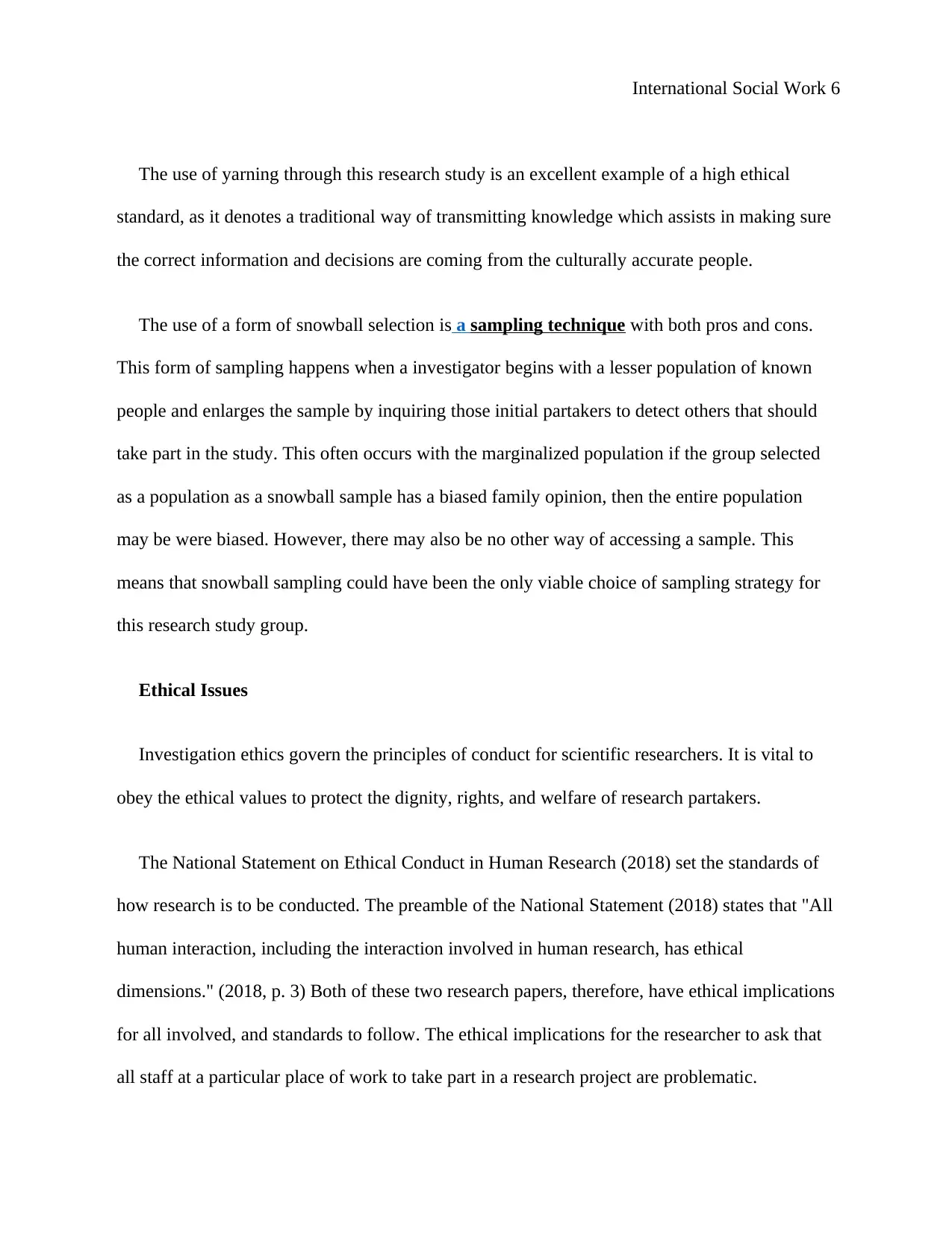
International Social Work 6
The use of yarning through this research study is an excellent example of a high ethical
standard, as it denotes a traditional way of transmitting knowledge which assists in making sure
the correct information and decisions are coming from the culturally accurate people.
The use of a form of snowball selection is a sampling technique with both pros and cons.
This form of sampling happens when a investigator begins with a lesser population of known
people and enlarges the sample by inquiring those initial partakers to detect others that should
take part in the study. This often occurs with the marginalized population if the group selected
as a population as a snowball sample has a biased family opinion, then the entire population
may be were biased. However, there may also be no other way of accessing a sample. This
means that snowball sampling could have been the only viable choice of sampling strategy for
this research study group.
Ethical Issues
Investigation ethics govern the principles of conduct for scientific researchers. It is vital to
obey the ethical values to protect the dignity, rights, and welfare of research partakers.
The National Statement on Ethical Conduct in Human Research (2018) set the standards of
how research is to be conducted. The preamble of the National Statement (2018) states that "All
human interaction, including the interaction involved in human research, has ethical
dimensions." (2018, p. 3) Both of these two research papers, therefore, have ethical implications
for all involved, and standards to follow. The ethical implications for the researcher to ask that
all staff at a particular place of work to take part in a research project are problematic.
The use of yarning through this research study is an excellent example of a high ethical
standard, as it denotes a traditional way of transmitting knowledge which assists in making sure
the correct information and decisions are coming from the culturally accurate people.
The use of a form of snowball selection is a sampling technique with both pros and cons.
This form of sampling happens when a investigator begins with a lesser population of known
people and enlarges the sample by inquiring those initial partakers to detect others that should
take part in the study. This often occurs with the marginalized population if the group selected
as a population as a snowball sample has a biased family opinion, then the entire population
may be were biased. However, there may also be no other way of accessing a sample. This
means that snowball sampling could have been the only viable choice of sampling strategy for
this research study group.
Ethical Issues
Investigation ethics govern the principles of conduct for scientific researchers. It is vital to
obey the ethical values to protect the dignity, rights, and welfare of research partakers.
The National Statement on Ethical Conduct in Human Research (2018) set the standards of
how research is to be conducted. The preamble of the National Statement (2018) states that "All
human interaction, including the interaction involved in human research, has ethical
dimensions." (2018, p. 3) Both of these two research papers, therefore, have ethical implications
for all involved, and standards to follow. The ethical implications for the researcher to ask that
all staff at a particular place of work to take part in a research project are problematic.
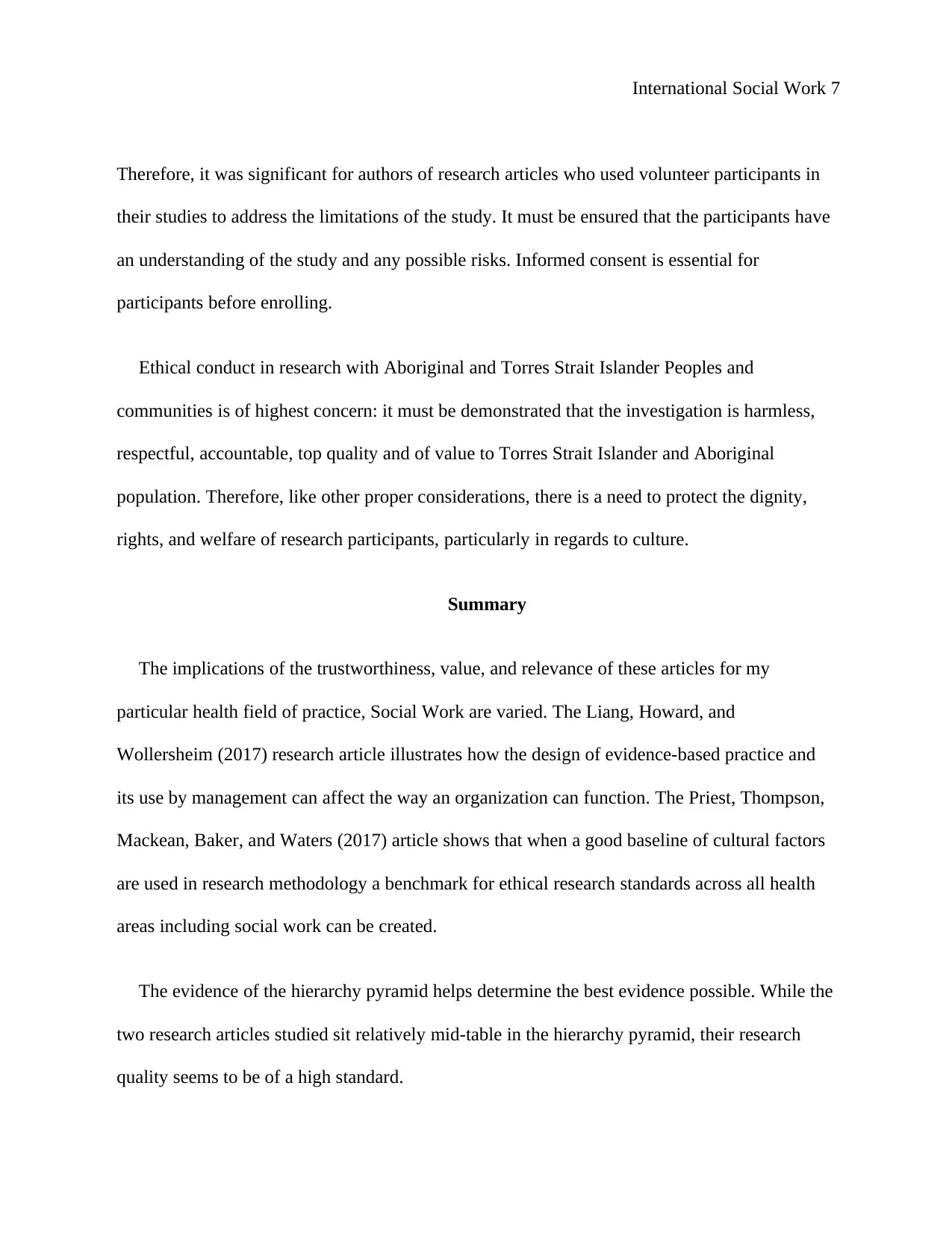
International Social Work 7
Therefore, it was significant for authors of research articles who used volunteer participants in
their studies to address the limitations of the study. It must be ensured that the participants have
an understanding of the study and any possible risks. Informed consent is essential for
participants before enrolling.
Ethical conduct in research with Aboriginal and Torres Strait Islander Peoples and
communities is of highest concern: it must be demonstrated that the investigation is harmless,
respectful, accountable, top quality and of value to Torres Strait Islander and Aboriginal
population. Therefore, like other proper considerations, there is a need to protect the dignity,
rights, and welfare of research participants, particularly in regards to culture.
Summary
The implications of the trustworthiness, value, and relevance of these articles for my
particular health field of practice, Social Work are varied. The Liang, Howard, and
Wollersheim (2017) research article illustrates how the design of evidence-based practice and
its use by management can affect the way an organization can function. The Priest, Thompson,
Mackean, Baker, and Waters (2017) article shows that when a good baseline of cultural factors
are used in research methodology a benchmark for ethical research standards across all health
areas including social work can be created.
The evidence of the hierarchy pyramid helps determine the best evidence possible. While the
two research articles studied sit relatively mid-table in the hierarchy pyramid, their research
quality seems to be of a high standard.
Therefore, it was significant for authors of research articles who used volunteer participants in
their studies to address the limitations of the study. It must be ensured that the participants have
an understanding of the study and any possible risks. Informed consent is essential for
participants before enrolling.
Ethical conduct in research with Aboriginal and Torres Strait Islander Peoples and
communities is of highest concern: it must be demonstrated that the investigation is harmless,
respectful, accountable, top quality and of value to Torres Strait Islander and Aboriginal
population. Therefore, like other proper considerations, there is a need to protect the dignity,
rights, and welfare of research participants, particularly in regards to culture.
Summary
The implications of the trustworthiness, value, and relevance of these articles for my
particular health field of practice, Social Work are varied. The Liang, Howard, and
Wollersheim (2017) research article illustrates how the design of evidence-based practice and
its use by management can affect the way an organization can function. The Priest, Thompson,
Mackean, Baker, and Waters (2017) article shows that when a good baseline of cultural factors
are used in research methodology a benchmark for ethical research standards across all health
areas including social work can be created.
The evidence of the hierarchy pyramid helps determine the best evidence possible. While the
two research articles studied sit relatively mid-table in the hierarchy pyramid, their research
quality seems to be of a high standard.
Paraphrase This Document
Need a fresh take? Get an instant paraphrase of this document with our AI Paraphraser
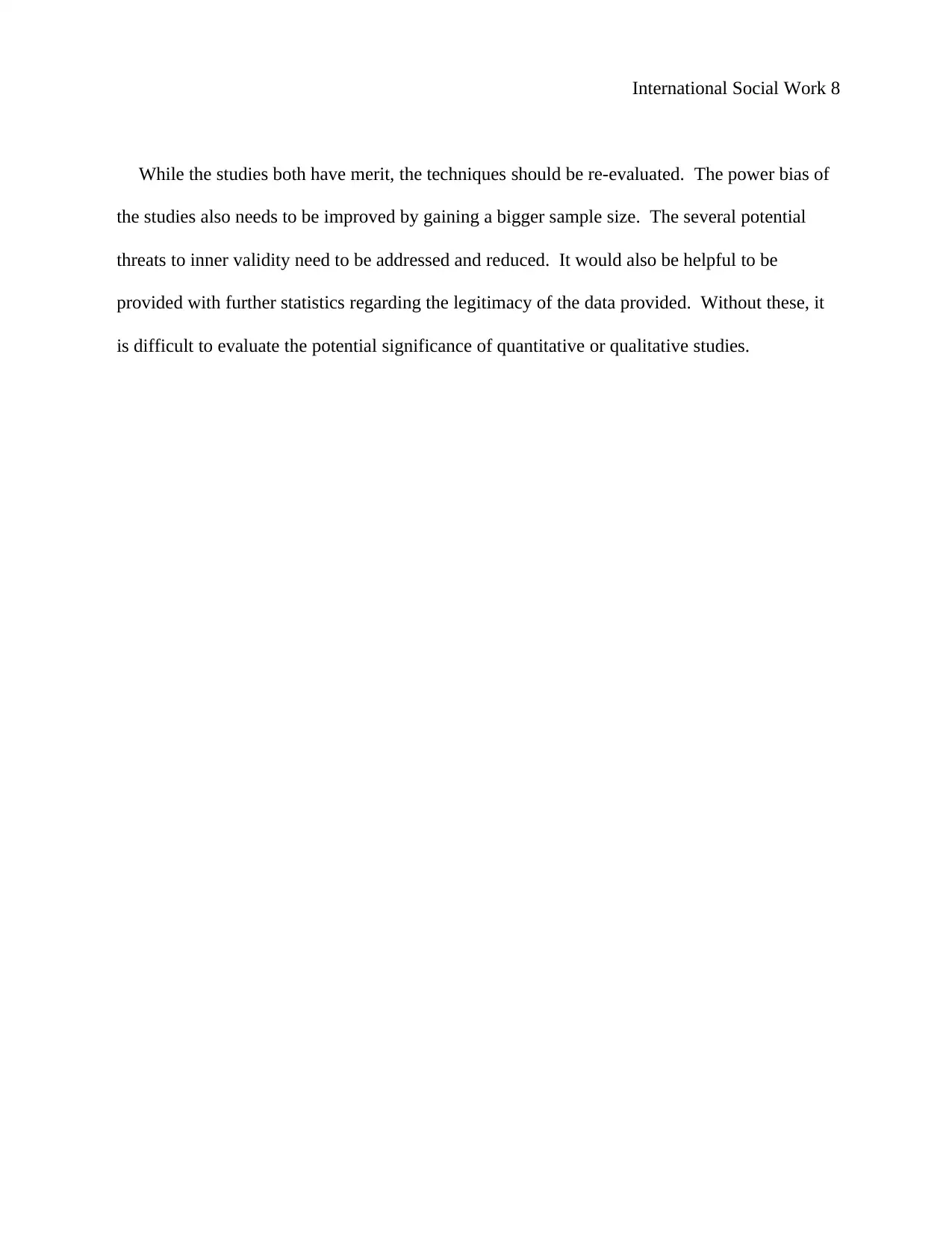
International Social Work 8
While the studies both have merit, the techniques should be re-evaluated. The power bias of
the studies also needs to be improved by gaining a bigger sample size. The several potential
threats to inner validity need to be addressed and reduced. It would also be helpful to be
provided with further statistics regarding the legitimacy of the data provided. Without these, it
is difficult to evaluate the potential significance of quantitative or qualitative studies.
While the studies both have merit, the techniques should be re-evaluated. The power bias of
the studies also needs to be improved by gaining a bigger sample size. The several potential
threats to inner validity need to be addressed and reduced. It would also be helpful to be
provided with further statistics regarding the legitimacy of the data provided. Without these, it
is difficult to evaluate the potential significance of quantitative or qualitative studies.
1 out of 8
Related Documents
Your All-in-One AI-Powered Toolkit for Academic Success.
+13062052269
info@desklib.com
Available 24*7 on WhatsApp / Email
![[object Object]](/_next/static/media/star-bottom.7253800d.svg)
Unlock your academic potential
© 2024 | Zucol Services PVT LTD | All rights reserved.





